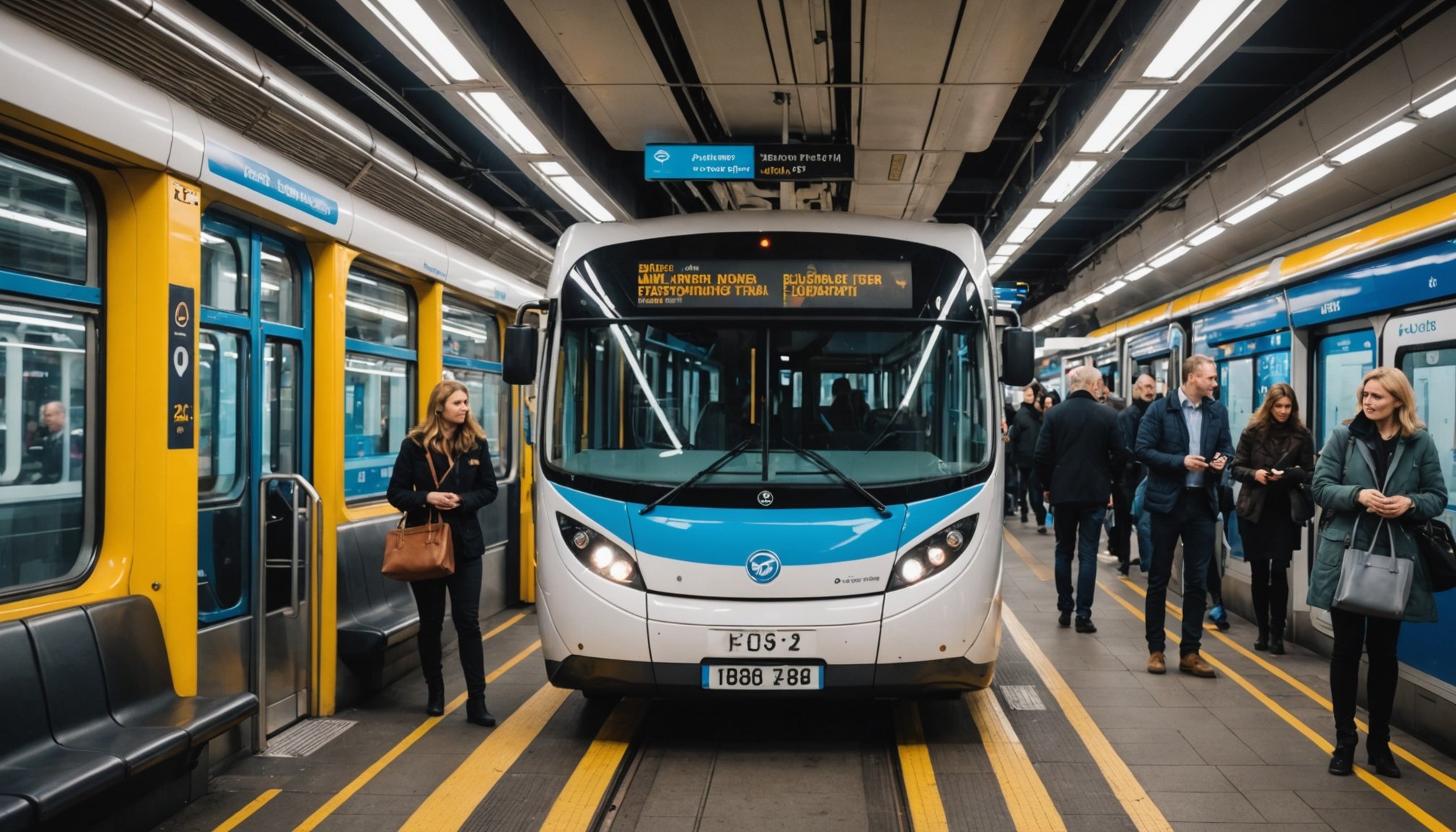Overview of AI in Public Transit
Artificial Intelligence (AI) is revolutionizing public transit integration, creating a shift towards more efficient, safe, and smart transportation systems. At its core, AI in public transportation leverages sophisticated algorithms to enhance decision-making processes, improve service delivery, and optimize resource allocation.
Definition and Scope
AI technologies such as machine learning and predictive analytics are pivotal in this evolution. Machine learning enables systems to learn from data patterns, improving over time without direct programming. Predictive analytics processes historical data to forecast future events, enabling better planning and scheduling in public transit.
Also read : Top Strategies for Successful AI Integration in UK Law Firms: Best Practices Revealed
Key AI Technologies
Predictive analytics enhances service reliability by anticipating passenger demands, ensuring timely vehicle dispatches, and reducing waiting times. Meanwhile, machine learning applications manage transportation resources effectively, minimizing fuel consumption and emissions.
Integration Process and Timelines
The integration of AI technologies in public transit is a phased approach. Initial steps include upgrading existing infrastructure and installing sensors to collect real-time data. This is followed by implementing machine learning and predictive analytics systems.
Topic to read : Transforming UK Healthcare: The Impact of AI on Diagnostics Innovations
The timeline for integrating AI into public transit varies widely. It depends on factors such as budget constraints, regulatory requirements, and technological infrastructure. Nevertheless, the transition towards a truly smart transportation network is steadily progressing, promising significant advancements in the near future.
Benefits of AI in Public Transit
Integrating AI technologies into public transit systems brings numerous advantages, starting with significantly enhancing operational efficiency through robust data analysis. By analysing real-time data, AI is able to optimise routes, manage traffic flows, and make informed schedule adjustments. This results in reduced waiting times for passengers and smoother transit operations.
The safety of transit systems is another area where AI demonstrates substantial impact. With AI monitoring systems, the prediction and prevention of accidents become more feasible. These systems can identify potential safety threats in real-time, leading to swift response actions by the authorities. Thus, this proactive approach reduces accidents and enhances passenger safety.
AI also plays a critical role in elevating the overall user experience. It offers personalized and real-time information tailored to individual passengers’ needs. For instance, AI can provide updates on delays, suggest alternate routes, and ensure a seamless commuting experience by adapting to the user’s personal itinerary preferences.
- Improved routing and transit efficiency
- Enhanced safety measures
- Personalized user experiences
In sum, AI technologies not only improve transit efficiency but also boost safety and a customized user experience, making public transit more responsive and reliable for its users.
Case Studies of AI Implementation in UK Public Transit
Artificial Intelligence (AI) is revolutionising public transportation systems across the UK. It introduces operational enhancements, boosts service efficiency, and enriches passenger experience.
London Transport System
In the bustling London transport network, AI applications are ubiquitous. These AI systems efficiently manage passenger flow and heighten service reliability, reducing delays significantly. Various technologies such as predictive analytics and machine learning algorithms have been embedded to forecast passenger volumes, thus optimising train schedules. As a result, the system sees fewer overcrowded trains and more on-time arrivals. Recent data highlights noteworthy efficiency gains, showing an increase in punctuality by over 20%.
Transport for Greater Manchester
Transport for Greater Manchester has adopted several state-of-the-art AI technologies designed to refine operational decision-making and enhance response times. Key systems include real-time data analysis and automated control systems, which streamline route adjustments and improve service recovery during disruptions. Feedback from passengers has been positive, appreciating the reduced wait times and increased reliability, while transit operators commend the ease of operational management these technologies bring.
Other Notable Examples
Beyond London and Manchester, other UK cities have successfully implemented AI within their public transit systems. These implementations illustrate different success factors such as integration speed and user adaptability. Examining these rich examples sheds light on AI’s transformative potential, offering valuable lessons for future transport solutions across various jurisdictions.
Statistical Improvements from AI Adoption
The integration of AI in public transit has led to notable shifts in key performance metrics, showcasing the ever-evolving landscape of transportation technology. Before the advent of AI-driven systems, traditional transit analysis reflected longer wait times and inconsistent service delivery. With the adoption of AI, these metrics experienced significant enhancements.
AI Statistics and Performance Metrics
Before AI, public transport systems frequently suffered from reliability issues. Post-integration, real-time AI statistics revealed a reduction in commuter wait times by up to 30%. This advancement doesn’t only improve efficiency but also positively impacts user experience. Increased use of predictive algorithms ensures buses and trains operate optimally, addressing peak ridership hours adeptly.
Quantitative Improvements
The benefits extend beyond punctuality, with increased ridership figures becoming an evident advantage. Many transit operators have reported up to a 15% increase in user engagement. This rise can be largely attributed to the real-time updates and streamlined operations enabled by AI.
User Satisfaction and Insight
User satisfaction surveys illustrate a transformation in commuter perceptions. Prior to AI, satisfaction rates hovered around 60%. Post-implementation, user feedback highlights a remarkable surge in satisfaction, reaching upwards of 85%. This change underscores AI’s capacity to transform complex transit systems into efficient, user-focused networks.
Expert Opinions on AI in Public Transit
The intersection of artificial intelligence and public transit offers a wealth of opportunities for innovation, according to expert insights from seasoned transportation professionals. In a series of interviews, these experts shared their AI perspectives on the industry’s future.
Transportation specialists predict that AI will revolutionise public transit with improved efficiency and enhanced rider experiences. One anticipated trend is the integration of AI-driven predictive analytics, which can optimise routes and schedules based on real-time data. Such innovations promise to reduce congestion and enhance the reliability of services.
However, the deployment of AI in public transit also raises ethical considerations. Ensuring data privacy and the equitable distribution of AI benefits are paramount to avoid potential biases and inequalities. Transportation professionals emphasise the need for responsible AI use, advocating for policies that protect user data and promote transparency.
Additionally, some expert insights emphasise the potential for AI to transform commuter interactions. Innovations like AI-powered customer service bots could offer 24/7 assistance, providing timely information and supporting a seamless travel experience. For the industry to successfully harness AI’s advantages, a collaborative approach involving all stakeholders—engineers, policymakers, and passengers—is crucial. This cooperation can ensure that AI deployment is not only technologically sound but also socially responsible.
Challenges of AI Integration in Public Transit
Integrating AI systems into public transit presents several AI challenges due to a variety of implementation barriers. A significant technical obstacle in this deployment is ensuring system interoperability. Many transit systems operate different technologies that don’t naturally communicate with AI solutions. These mismatched technologies require substantial adaptation, resulting in prolonged implementation processes.
Furthermore, the challenge of data privacy and security is of paramount concern. Public transit relies heavily on data collection, such as passenger flows and travel patterns, which raises privacy issues. Strict regulations necessitate robust measures to protect this data, making AI accuracy essential for logical decision-making without compromising personal information.
Resistance to change is another critical challenge faced in AI advancements within public transit. Transit employees may fear job displacement, while users might doubt the efficiency and reliability of AI-driven systems. Encouraging stakeholder buy-in involves demonstrating the potential of AI to enhance operational efficiency and passenger experience, which requires meticulous planning and clear communication.
Addressing these public transit issues involves balancing technological advances with stakeholder concerns, ensuring that AI-driven solutions can be effectively integrated and trusted. Substantial focus on education and training for transit staff, along with transparent communication with the public, can pave the way for seamless transitions to smarter transit systems.
Future Trends in AI and Public Transit
Exploring future trends in public transit reveals a shift powered by transportation innovations and the evolution of AI. How will AI technologies reshape the landscape? It’s anticipated that they will continue to advance rapidly, ensuring more efficient and sustainable transit systems. AI’s potential to minimize congestion and reduce operational costs while enhancing commuter experiences is significant.
In the realm of technology, potential partnerships and collaborations between AI developers and transit agencies are promising. These partnerships aim to address challenges such as predictive maintenance, dynamic scheduling, and real-time decision-making. Future collaborations may focus on creating seamless transit experiences across different modes of transport, integrating ticketing, and improving accessibility for all users.
The vision for a fully integrated, AI-driven public transportation ecosystem is both ambitious and feasible. Imagine a world where autonomous vehicles, drones, and smart infrastructure work in harmony to provide flexible and adaptable transportation solutions. AI will likely play a central role in managing these systems, from optimizing routes to ensuring passenger safety.
Such advances are poised to transform urban mobility, offering a glimpse into a future where transportation is more connected, intuitive, and responsive to societal needs. As these trends unfold, public transit will become an even more integral part of urban living.










